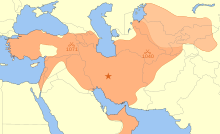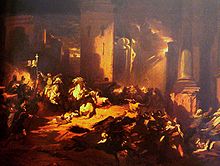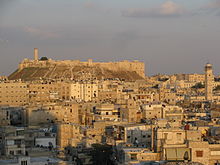Fakhr al-Mulk Ridwan
| Ridwan | |||||
|---|---|---|---|---|---|
Emir of Aleppo | |||||
| Reign | 1095–1113 | ||||
| Predecessor | Tutush I | ||||
| Successor | Alp Arslan al-Akhras | ||||
| Born | c. 1077 | ||||
| Died | 10 December 1113 Aleppo | ||||
| Burial | Meşhedülmelik | ||||
| Consort | Jijak Khatun[1] | ||||
| Issue | Alp Arslan al-Akhras Malik Shah Mubarak Shah Sultan Shah Farkhunda Khatun Amina Khatun | ||||
| |||||
| House | Seljuk | ||||
| Father | Tutush I | ||||
| Mother | Safwat ul-Mulk Khatun | ||||
| Religion | Sunni Islam | ||||
Ridwan
Ridwan was born to the Seljuk prince Tutush, who had established a principality in Syria after his brother, Sultan Malik-Shah I granted him the region and its adjacent areas as an appanage. After the death of Malik-Shah, Tutush claimed the Seljuk crown, but he was killed by the forces of his nephew Berkyaruq near Ray, Iran. Following this, Ridwan moved to Aleppo and proclaimed himself the new emir. His brother Duqaq's declaration of a new emirate in Damascus split the Syrian Seljuk state in two and started a rivalry between the brothers which continued even after the arrival of the First Crusade in 1097. Ridwan tried to banish the Crusaders with gold, and fought the Principality of Antioch, a Crusader state established after the end of the Siege of Antioch in 1098. Bohemond I of Antioch invaded Ridwan's domain and reached Aleppo's surroundings. Bohemond's successor, Tancred, regent of Antioch, also warred against Ridwan, but the two later allied in a conflict against the emir of Mosul, Jawali Saqawa, supported by Baldwin II of Edessa and Joscelin I, the Lord of Turbessel.
Ridwan's personality was shrouded in mystery.
Background
Fakhr al-Mulk Ridwan was born around 1077.[4] He was the eldest of five sons of Taj ad-Dawla Tutush,[7] the brother of the Seljuk Sultan Malik-Shah I,[5] and the mayor of Ganja in Arran.[8] In 1078, Malik-Shah sent Tutush to conquer Syria and the adjacent areas as an appanage,[9] creating a principality there.[10] Tutush besieged and conquered Aleppo the next year, while a Fatimid army simultaneously besieged Damascus. Thereupon, the Turcoman ruler of Damascus, Atsiz ibn Uwaq (r. 1071–1079) asked for help from Tutush. Having heard that Tutush was coming, the Fatimid forces retreated. Even though Atsiz accepted Tutush's suzerainty, Tutush had Atsiz strangled with the bowstring of his bow on the pretext that he was late to greet him and that he was conspiring against him with his brother.[8] Tutush conquered Southern Syria and Palestine, capturing Jerusalem, Damascus, Acre, Tyre, Tripoli, Jaffa, and Arish, as well as the region of Galilee, previously held by Atsiz, and founded the Syrian Seljuk State.[9][11]

Tutush struggled with the
Reign
Ridwan's rivalry with Duqaq
Ridwan learned of his father's death while he was camping in Anah and returned immediately to Aleppo and took over the Syrian Seljuk throne. The Turcoman ruler of Antioch, Yaghi-Siyan, gave his daughter to Ridwan in marriage and recognised Ridwan as his overlord, with coins being struck in his name in the city. Ridwan, fearing that they might gain power and overthrow him, strangled his two brothers,[20] Abu Talib and Behram,[7] while his other brother, Duqaq, accompanied by the atabeg Janah ad-Dawla al-Husain, sneaked out of Aleppo and moved to Damascus, founding a separate state there. Ridwan did not recognise Duqaq's domain and proclaimed himself the sole legitimate ruler of the Syrian Seljuks. Thereupon, Ridwan besieged Damascus but failed to seize it and had to return to Aleppo. Thus, the Syrian Seljuk state was divided into two rival halves, ruled from Aleppo and Damascus.[10][18][21][22]
In 1096, Ridwan wished to expand his domain and besieged
Crusades and Isma'ilism

Ridwan prepared to attack Duqaq and Janah ad-Dawla, who had established an independent emirate in
Meanwhile, Ridwan made peace with Janah ad-Dawla in Nukrah.
Conflicts and alliance with Tancred
In general, Ridwan tried to banish the Crusaders with gold, despite being characterised as a "rapacious miser" among the Shia and Sunni Muslims in his domain. The regent of Antioch, Tancred, who forcibly collected money from the rural locals, made peace with Ridwan, in return receiving 7000 gold dinars and 10,000 cattle and sheep. Ridwan profited from Soqman ibn Ortoq's victory over the Crusaders in the Battle of Harran in 1104 and took back the cities and fortresses occupied by the Crusaders.[25] Ridwan's brother and rival, Duqaq, died of tuberculosis on 6 June 1104, after which Ridwan moved to Damascus and gave khutbah in his own name,[21] though Duqaq was succeeded by his son, Tutush II.[18] Soon after, Tutush II and his relatives were set aside by his atabeg, Toghtekin,[25] and the Turkish[28] Burid dynasty succeeded the Seljuks in Damascus.[29]

In 1105, Ridwan left Aleppo to aid the qadi of Tripoli,
While Tancred was in Edessa, Ridwan launched raids against Antioch to reclaim the lands surrounding Aleppo but retreated after learning of Tancred's arrival. Ridwan's situation worsened when Tancred attacked east of Aleppo in retaliation. Ridwan gave Tancred 20,000 dinars, and 10,000 horses, as well as two fortresses in the vicinity of Aleppo, and freed the captives he had taken during his raids, in exchange for peace. This agreement caused a famine around Aleppo, and Ridwan had to sell the lands from his own
Last years

Ridwan's financial situation worsened. His attempt to confiscate the goods of a merchant named Abu Harb Isa from Khorasan, in cooperation with the Isma'ilis, greatly damaged his reputation. When the atabeg Toghtekin came to lead the Muslim armies against Sidon or Tripoli, he passed by Damascus, where Ridwan tried to assassinate him, but dropped this plan when he learned Tancred was preparing to invade Azaz, and asked Toghtegin for help. In 1112, they signed a defensive treaty at Aleppo, in return of for recognition of Ridwan's formal sovereignty over Damascus. When Baldwin I of Jerusalem invaded Damascus, Toghtegin asked Ridwan for help, but the latter sent only a small force of 100 horsemen. Toghtegin was angered by this and ended the Friday sermon given in Ridwan's name in Damascus on 16 August 1113.[21][25] On 2 October 1113, Mawdud, one of the commanders of the Muslim expedition, was assassinated after his prayers in the Umayyad Mosque of Damascus.[32]Toghtegin accused Ridwan and his Assassin allies of the deed, though most of his contemporaries believed that Toghtegin himself was behind the act.[31]
Death and succession
Ridwan died on 10 December 1113 in Aleppo and was buried in Meşhedülmelik.[21] Following Ridwan's death, groups of armed militiamen, instigated by Ibn al-Khashab, flooded the streets of Aleppo, occupied the major buildings and captured many of Ridwan's supporters, notably the members of the Order of Assassins, who were immediately put to death, accused of treachery and collaboration with the Crusaders.[24][33] Meanwhile, the realm passed to his 16 year-old son, Alp Arslan, who stuttered so severely that he was nicknamed al-Akhras (The Mute). His reign, and the following reign of 6 year-old[33] Sultan Shah ibn Radwan, is generally accepted as being under the de facto rule of the atabeg Lu'lu' al-Yaya. Alp Arslan initially followed his father's pro-Isma'ili policy, giving them a castle outside of Balis. Despite this, the Seljuk sultan Muhammad I, sent a letter to Alp Arslan, warning him of the dangers of the Assassins and urging him to purge them. Forced by Aleppo's population and his patron, Alp Arslan took a series of vigorous measures against the Isma'ilis, putting Abu Tahir al-Sa'igh, the chief Nizari Isma'ili da'i of Syria, and other leading figures to death, and killing or imprisoning about two hundred of the order's members. The massacres of the Isma'ilis effectively eradicated a significant portion of Aleppo's Isma'ili population and eliminated the so-called Assassin threat, though it also deprived Alp Arslan from his only possible support. He also executed two of his brothers, several officers, a few servants, and anyone to whom he took a dislike, which caused discomfort among Aleppans. Alp Arslan then sought Toghtekin's protection, but this caused distrust among Aleppo's Shi'a population. Alp Arslan was killed in 1114 on his own atabeg's initiative, and anarchy ensued, while Ridwan's slaves and Aleppo's nobility each tried to impose their authority among the townsmen.[12][23][25][33][34] The rule of the Seljuk dynasty in Aleppo soon ended in 1118.[10]
Notes
References
Citations
- S2CID 226684474.
- ^ Ayan & Özen 2016, p. 34.
- ^ Bosworth 1968, p. 108.
- ^ a b c Maalouf 1984, p. 22.
- ^ a b Setton & Baldwin 1969, pp. 170–171.
- ^ Gibb 1935, pp. 739–754.
- ^ a b Duman 2016, p. 117.
- ^ a b Sevim 1991, pp. 92–93.
- ^ a b Bosworth 1968, p. 98.
- ^ a b c Schulze 2008, pp. 321–330.
- ^ Özaydın 2012, pp. 446–449.
- ^ a b c d e Sümer 2009, pp. 385–386.
- ^ Bosworth 1988, pp. 800–801.
- ^ Cahen 1960.
- ^ a b c Peacock 2015, p. 76.
- ^ Bosworth 1968, p. 103.
- ^ Bosworth 1968, p. 105.
- ^ a b c d Özaydın 2016, pp. 342–343.
- ^ Tetley 2008, p. 128.
- ^ a b Maalouf 1984, pp. 23–28.
- ^ a b c d e f g h i Sevim 2008, pp. 49–50.
- ^ a b Setton & Baldwin 1969, pp. 309–327.
- ^ a b Ayan & Özen 2016, p. 39.
- ^ a b c Setton & Baldwin 1969, pp. 110–111.
- ^ a b c d e f g Setton & Baldwin 1969, pp. 172–174.
- ^ Setton & Baldwin 1969, pp. 164–165.
- ^ Ayan & Özen 2016, p. 42.
- ^ LeTourneau 1960, p. 1332.
- ^ Richards 2010, p. 16.
- ^ Maalouf 1984, p. 72.
- ^ a b Maalouf 1984, pp. 83–86.
- ^ Cobb 2016, p. 120.
- ^ a b c Maalouf 1984, pp. 90–91.
- ^ Setton & Baldwin 1969, pp. 113–114.
Sources
- Ayan, Necmettin; Özen, Firdevs (24 December 2016). "The Citadel of Aleppo During the Seljuk Period in Historical Process". Turkish Studies (in Turkish). 12. Ankara: 33–54. ISSN 1308-2140.
- ISBN 0-521-06936-X.
- ISBN 978-0-71009-120-8.
- OCLC 495469456.
- Cobb, P.M. (2016). The Race for Paradise: An Islamic History of the Crusades. Oxford University Press. ISBN 978-0-19-061446-1. Retrieved 29 July 2022.
- Duman, İbrahim (26 January 2016). "Dımaşk Selçuklu Meliki Ertaş b. Tutuş". Journal of Turkology (in Turkish).
- S2CID 153994216.
- OCLC 495469456.
- ISBN 0-8052-0898-4.
- Özaydın, Abdülkerim (2012). "Tutuş". TDV Encyclopedia of Islam, Vol. 41 (Tevekkül – Tüsterî) (in Turkish). Istanbul: ISBN 978-975-389-713-6.
- Özaydın, Abdülkerim (2016). "Dukak b. Tutuş". TDV Encyclopedia of Islam, Supplement 1 (Abazalar – Kaftan) (in Turkish). Istanbul: ISBN 978-975-389-878-2.
- ISBN 978-0-7486-3826-0.
- Richards, D. S. (2010). The Chronicle of Ibn Al-Athir for the Crusading Period from Al-Kamil Fi'l-ta-Ta'rikh. ISBN 9780754669500.
- Schulze, Wolfgang (2008). "An anonymous copper coin re-attributed from Trebizond to Syria". JSTOR 42678770.
- ISBN 0-299-04834-9.
- Sevim, Ali (1991). "Atsız b. Uvak". TDV Encyclopedia of Islam, Vol. 4 (Âşik Ömer – Bâlâ Külli̇yesi̇) (in Turkish). Istanbul: ISBN 978-975-389-431-9.
- Sevim, Ali (2008). "Rıdvân b. Tutuş". TDV Encyclopedia of Islam, Vol. 35 (Resûlîler – Sak) (in Turkish). Istanbul: ISBN 978-975-389-457-9.
- Sümer, Faruk (2009). "Suriye Selçukluları". TDV Encyclopedia of Islam, Vol. 36 (Sakal – Sevm) (in Turkish). Istanbul: ISBN 978-975-389-566-8.
- Tetley, Gillis (2008). The Ghaznavid and Seljuk Turks: Poetry as a Source for Iranian History. Routledge. ISBN 978-1-134-08438-8.
